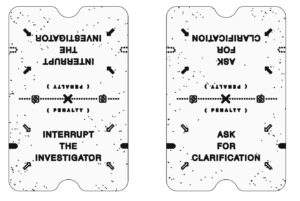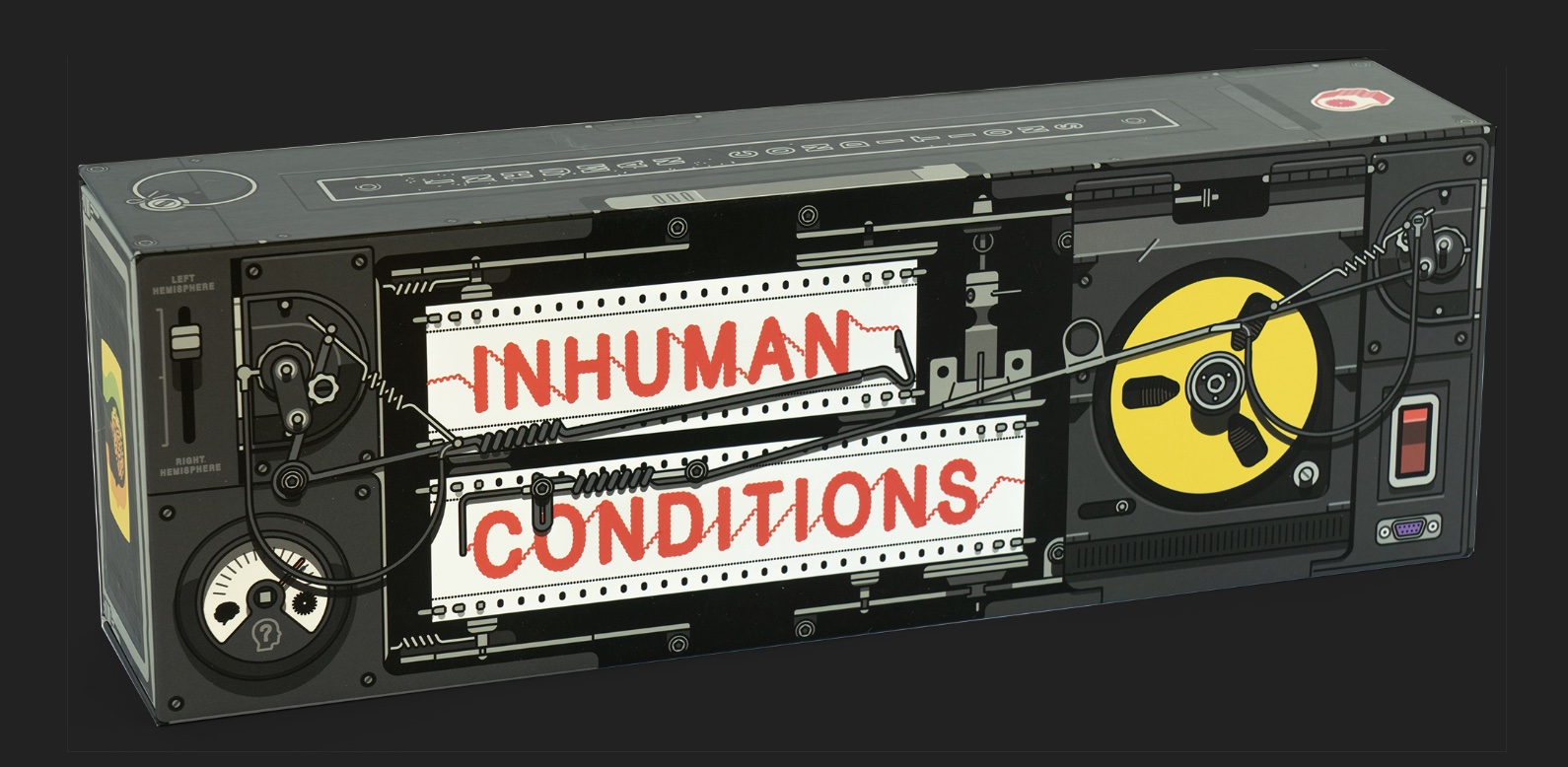Among all the other games in the list, I chose one that was most unfamiliar to me — Inhuman Conditions. I was also curious about it because it seemed to be the only one with just two players. Inhuman Conditions was designed by Tommy Maranges and Cory O’Brien, illustrated by Mackenzie Schubert. Originally a card game played between people face to face, the game has been adapted into an online version (named Robot Interrogation) that can be played on any device with a browser. Though I played the game with a friend in person, we used the online version for convenience. The game is premised on science fiction, and requires a certain degree of communication and deduction skills, so young children probably wouldn’t be able to enjoy the game. Other than that, I would say the game’s target audience is anyone who has a taste for social deduction games.
Set in a background of science fiction and bureaucracy, Inhuman Conditions is played by two people, one acting as an investigator, and the other as a suspect. The suspect can be either a human, or a robot. It is the investigator’s job to interview the suspect and determine whether the suspect is a human or a robot. The suspect’s goal is not to get reported, so they must act as human as possible regardless of their actual identity. Robots have certain quirks (also called “penalties”) that must be met during the interview. Suspects who get stamped as a robot by the investigator as well as investigators who make the incorrect determinations get sent to the “Bureau’s Invasive Confirmation Unit”, or in other words, lose the game. One round of the game involves one investigation that ends in the investigator making the determination of whether the suspect is a human or a robot. For me, I thought the fun of the game was in mastering the navigation of the robot penalties in the communication. The thrill of the game is when the investigator correctly identifies whether penalties were performed and learns the identity of the suspect, when the robot manages to deceive the investigator by doing penalties discretely, or when the human protects themselves by avoiding the penalties successfully. It all involves mentally mastering the skill of spotting and controlling patterns in the conversation.
An interesting thing about this game is that the formal elements of the game can be different depending on how you look at it.
-
- Player vs. player: When the suspect is a robot, this game can be considered a classic player vs. player game, where the investigator tries to figure out whether the suspect is a robot and the suspect tries to hide their true identity. The objective in this case is to outwit, and the outcome is zero-sum, where either the investigator wins or the robot wins.
- Cooperative play: When the suspect is a human, the game becomes more like a cooperative play, where both players need to work together to get on the same page about the suspect being a human. In this case the objective might be finding a solution, while the outcome is a non-zero-sum game, whether both players win if the investigator correctly identifies the suspect as a human, and lose otherwise.
Inhuman Conditions is quite similar to other popular social deduction games, such as Werewolf and Mafia, in the sense that it is based on one party trying to figure out the identity of the other party while the other party tries to convince or deceive about their identity. The elements of communication and social behavior are common in these games. However, Inhuman Conditions sets itself apart by being a 2-player game, instead of a party game where many people can join in. In my opinion, there are pros and cons to this twist. One of the most interesting thing about social deduction games such as Werewolf that I like is the interpersonal exchanges between multiple players. The social interactions are far more complicated and fascinating when it involves more people — people behave differently towards different people, so when there are more people around we can see more diverse behaviors! However, it also means that the interaction between any two players may not be as strong and substantial. With Inhuman Conditions, players only focus on a single person — the other player. The interaction between players in Inhuman Conditions is likely deeper and more personal.
During the rounds of Inhuman Conditions that I played with my friend, an epic fail in the game (in my opinion) was when I was the investigator, my friend was a human, and the robot penalty we drew was “Interrupt the Investigator”. It was epic fail not because we lost, but because we won — too easily. I felt that in the scenario of an interrogation, it is natural for the suspect not to interrupt the investigator. So it was very easy for my friend to behave like a human (nothing special had to be done) and it was very easy for me to determine she didn’t interrupt me even once during the entire 5 minute interrogation. We both agreed that this round was particularly boring. I felt that the robot penalties should be designed to be harder for the investigator to detect or easier for a human to mistakenly do. Some of the penalties designed for the game seem appropriate, such as “ask for clarification”, but others (like “interrupt the investigator”) may need some revising.

One area of improvement that I would like to see in the online version of Inhuman Conditions is that it removed too much of the fiction context. Though the underlying patterns of the game is preserved, it is somewhat hard to get onboard without the cool aesthetics of the original game. Make-believe and aesthetic appreciation also bring delight and can be a form of fun. Without any of it, the online version Robot Interrogation seemed a bit too bland and not visually attractive enough to spike the interests of new players.




